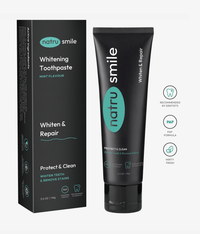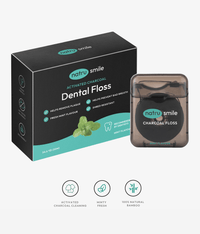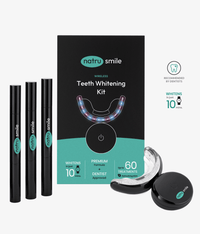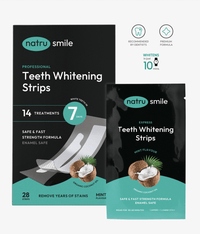
All products are certified by dental expert Dr. Greg Grillo
If you're looking into teeth whitening options, you've undoubtedly come across Zoom—a newer teeth whitening system that can be done in a dentist's office. But before you rush to the dental clinic, you should know the facts about Zoom teeth whitening and how much it costs. This article tells you everything you need to know, so you can make an educated decision.
With the massive growth in demand for teeth whitening procedures, innovations in the field are becoming more and more common. Zoom teeth whitening is the latest of these advances, allowing you to achieve a brighter, whiter smile in just one office visit.
Because of its convenience compared to other teeth whitening options out there, Zoom whitening is taking up an increasing amount of the $6.9 billion market share.
But how does it work?
And how much does it cost?
This guide tells you everything you need to know about Zoom whitening, so you can decide whether it's right for you and prepare for upcoming treatment.
What Is Zoom Teeth Whitening, And How Does It Work?
Zoom teeth whitening is a popular in-office whitening treatment that effectively whitens teeth by removing deep-seated stains and discoloration. This professional procedure is designed to produce immediate, long-lasting results in just one session, typically lasting about an hour.
The Zoom whitening process can be broken down into two main steps:
-
Preparation: First, your dentist will thoroughly examine your teeth and gums to ensure you're a suitable candidate for the treatment. They will then clean your teeth to remove any plaque or debris. A rubber dam and/or protective gel will be applied to protect your gums and mouth tissues while isolating the teeth for whitening.
- Whitening: The dentist will apply a hydrogen peroxide-based whitening gel to your teeth. This gel penetrates the tooth enamel to break up stains and discoloration. The ultraviolet light from the Zoom lamp is then directed onto the teeth, activating the gel and accelerating the whitening process. This light exposure typically lasts for 15 minutes and is repeated in three intervals for a total treatment time of 45 minutes.
Recently, Zoom whitening is available as an at-home procedure as well. This procedure is not carried out under dental supervision, which means it is not as effective.
Still, both options for Zoom whitening are more advanced than their respective traditional counterparts. Extensive clinical research from Philips points to both the safety and efficacy of Zoom whitening.
Advantages Of Zoom Whitening
The Zoom system offers a few distinct advantages compared to traditional in-office teeth whitening.
UV light enhances the effectiveness of the hydrogen peroxide gel, often resulting in more significant whitening than with gel alone.
When comparing Zoom to regular in-office teeth whitening, the process is also generally faster in the former than the latter—which may require multiple sessions to achieve the desired results.
It's worth noting that both Zoom and traditional in-office teeth whitening methods are far more effective and efficient than at-home whitening solutions, as they use higher concentrations of whitening agents and are performed by dental professionals who can customize the treatment to your specific needs.
One study showed Zoom technology to be 50% more effective than other leading teeth whitening options on the market.
In terms of teeth whitening costs, Zoom is actually cheaper than other professional whitening solutions because of its effciency. Its average per-visit cost is also less than some other professional options.
Disadvantages Of Zoom Whitening
Zoom whitening is a new procedure. As such, it offers some of the most advanced whitening technology on the market. Still, there are a few potential downsides that you should consider before having the treatment.
Zoom whitening is considered more aggressive than other treatments, meaning it may cause some sensitivity to your teeth and gums. Especially if you suffer from chronic sensitivity, you can expect to experience side effects from teeth whitening if you choose Zoom.
Both Zoom's in-office option and its teeth whitening kits are also more expensive than other methods. The cost of Zoom whitening depends on various factors, but is generally higher than than some of your other teeth whitening options.
How Much Does Zoom Teeth Whitening Cost?
The actual cost of Zoom whitening treatment varies based on several factors:
- The amount of whitening needed
- The level of accessibility to Zoom whitening in your area
- Whether you opt for an in-office or at-home version
- Your dentist's individual rates and policies
- Additional products (e.g., special toothpaste, mouthwash, etc.)
A Zoom whitening package typically costs between $300 and $600. This includes your 45-minute dental appointment and an aftercare package they will provide you.
The frequency with which you need to use the Zoom whitening system is another critical factor that impacts the cost of Zoom whitening. It is worth noting that Zoom is both faster and longer-lasting than many other dental whitening options, making it both a sound investment in the short and long term.
Is Zoom Teeth Whitening Worth It?
Research proves both Zoom's advantages and disadvantages.
Patients whitening their teeth with Zoom treatments can expect excellent results in less time. But they can also expect higher levels of sensitivity, especially if they are already prone to it.
Whether Zoom whitening's cost is worth it to you depends on several factors:
- Where you live and the cost of whitening treatments in your area.
- Your budget for teeth whitening.
- Whether you are willing to endure sensitivity for a better result.
- Your end goal - how white do you want your teeth?
You will also want to compare the benefits of in-office vs. at-home whitening when making your decision.
If you find the cost to be out of your range or not worth the benefits, you can also try natural teeth whitening, which can be done using pantry items like baking soda and olive oil.
In-Office Zoom Teeth Whitening Treatments
The most popular option for Zoom whitening is its in-office treatment.
During this procedure, a dental professional applies the hydrogen peroxide gel to your teeth. Then, they expose it to UV light for 15 minutes, three times in total, to activate the gel and accelerate the whitening process.
Because of the speed of these treatments, working an appointment into your schedule is easy, even if you have work or personal responsibilities during the day.
At-Home Zoom Teeth Whitening Kits
Zoom's at-home whitening kits offer an alternative option.
These kits come with a custom-fitted tray, hydrogen peroxide gel, and instructions on how to use them. With this option, you can whiten your teeth in the comfort of your own home, at your convenience.
While this option is more affordable than Zoom's in-office treatment, it can takes slightly longer to show results. It is also more error-prone, as it is done without professional supervision or application.
How Long Does Zoom Teeth Whitening Last?
In a single visit, Zoom is clinically shown to whiten teeth up to eight shades. But it also lasts quite a while. With proper care and oral health maintenance, most patients see lasting results for between 12 and 24 months.
Is Zoom Teeth Whitening Safe?
Numerous clinical studies have proven that Zoom whitening is safe. And its new whitening gel produces fewer side effects, even in sensitive patients.
The overall safety of hydrogen peroxide gel depends on the amount used and how often it is applied to the enamel, though.
When used as directed, these procedures are completely safe. But some patients over-whiten their teeth by using Zoom or other whitening products too often, using them in conjunction with whitening toothpaste, or using them with too high of a peroxide concentration for their specific needs.
When using at-home Zoom whitening, there is also the risk of improper use or application.
For these reasons, it is important to always use Zoom whitening treatments as directed and not exceed the number of applications recommended by your dental professional.
Want to learn more? These are the questions our customers ask us the most.
Does Zoom Teeth Whitening Hurt?
In recent years, improvements to the Zoom gel formula have reduced the risk of potential side effects, like tooth sensitivity and gum irritation.
However, some patients still report some levels of sensitivity during and after the procedure. This can usually be managed with ibuprofen or other over-the-counter pain medications.
Patients who are highly sensitive to other kinds of whitening treatments might not be able to handle Zoom, but the only way to know for sure is to speak with your dental professional and discuss your concerns.
Zoom Whitening Aftercare Tips
After investing in a Zoom teeth whitening treatment, following specific aftercare guidelines is essential to keep your teeth white and ensure long-term oral health.
Here are some detailed aftercare tips to help you get the most out of your Zoom whitening procedure:
1. Avoid Stain-Causing Food And Drinks.
For the first 48 hours after treatment, your teeth may be more susceptible to staining. It's essential to avoid foods and drinks that can cause discoloration, such as:
- Coffee and tea
- Red wine
- Dark-colored sodas
- Berries and other dark fruits
- Tomato-based sauces
- Soy sauce
- Dark chocolate
2. Use A Straw When Drinking Fluids.
If you must consume beverages that could stain your teeth, use a straw to minimize contact between the liquid and your teeth.
Straws help keep beverages away from your front teeth, making preserving the whitening results achieved with Zoom easier.
3. Maintain Proper Oral Hygiene.
Even in the days immediately following your treatment, regular brushing and flossing are crucial to preserving your whitened teeth. Brush at least twice a day using fluoride toothpaste and floss daily to remove plaque and prevent stains from setting in.
It's also important to remember that Zoom and other teeth whitening procedures are not replacements for proper oral hygiene. Teeth are not naturally white, and they are not any more protected from cavities because of whitening treatments.
4. Visit Your Dentist For Regular Cleanings.
Bi-annual professional dental cleanings are essential to maintain your teeth's health and appearance.
During your visit, your dentist can evaluate your teeth, recommend any necessary dental treatments, and ensure that your Zoom treatment is still intact.
5. Avoid Tobacco Products (And Vaping).
Tobacco use can lead to teeth staining and negatively impact your oral health. If you smoke or use other tobacco products, consider quitting to preserve your bright smile.
Vaping can also be problematic to your whitening results. Since vaping is closely related to your oral health, quitting or avoiding vaping is strongly recommended.
6. Limit Acidic Foods And Beverages.
Acidic foods and drinks can soften tooth enamel, making it more vulnerable to staining. Examples include:
- Vinegar-based dressings and sauces
- Citrus fruits and juices
- Sports drinks
- Kombucha
- Soda
7. Limit Your Intake Of Foods That Stain Your Teeth.
Any food with strong colorments can potentially stain your teeth.
Examples include:
- Curries
- Tomato sauces
- Soy sauce
- Blueberries
- Beets
- Coffee
- Black tea
- Red wine
8. Use A Touch-Up Kit.
Your dentist may provide you with a touch-up kit to use at home periodically. These kits usually include custom trays and whitening gel to help maintain the results of your Zoom treatment.
You can also purchase teeth whitening pens and strips to use as needed. If you choose to purchase these products, take care not to over-whiten your teeth and damage your enamel.
9. Be Mindful Of Tooth Sensitivity.
Some patients may experience tooth sensitivity after the Zoom whitening procedure.
If you're experiencing discomfort, use toothpaste specifically designed for sensitive teeth and avoid extremely hot or cold food and drinks for a few days.
If your sensitivity continues, you may want to consider other teeth whitening options—Zoom could be too strong for your teeth.
When Is It Best To Talk With A Dentist About Zoom Teeth Whitening?
Deciding when to talk with a dentist about Zoom teeth whitening depends on your unique circumstances and dental needs. People might want to improve their smile with this treatment for numerous reasons.
Here are some of the most common motives for seeking professional teeth whitening:
-
Discolored or stained teeth. Teeth can become stained or discolored over time due to various factors, including consuming certain foods and beverages, smoking, and aging. If you notice your teeth aren't as white as they used to be, it may be time to discuss Zoom whitening with your dentist.
-
Upcoming special events. People often want to look their best for significant life events, such as weddings, reunions, or graduations. If you have an upcoming event where you'd like to showcase a bright, confident smile, consider scheduling a consultation with your dentist to discuss Zoom whitening.
-
Boost self-confidence. A brighter smile can lead to increased self-confidence and improved self-esteem. If you feel self-conscious about your discolored teeth, Zoom teeth whitening can help restore your confidence in your appearance.
-
Enhance your professional image. In some professions, having a polished appearance is crucial for success. A bright, white smile can create a positive impression and improve your professional image, making you more approachable and trustworthy in the workplace.
-
Reversing the effects of certain medications. Some medications, such as tetracycline, can cause tooth discoloration. If your teeth have been affected by medication-related staining, your dentist might recommend Zoom teeth whitening to restore your smile.
-
Counteract fluorosis. Excessive fluoride intake during childhood can cause a condition called fluorosis, which leads to white or brown spots on the teeth. Zoom whitening can help improve the appearance of teeth affected by fluorosis.
- Long-lasting results. If you've tried at-home whitening treatments with limited success or short-lived results, you may want to talk to your dentist about Zoom teeth whitening. This professional treatment often provides more significant and longer-lasting results than over-the-counter whitening products.
The Takeaway
If you want to improve your smile, Zoom whitening is one of the best options available. It's a safe, effective way to whiten your teeth and enhance your overall appearance.
Before deciding to undergo this procedure, talk to your dentist about the potential risks and costs associated with Zoom whitening. With their help, you can determine if this treatment is right for you.
If you decide to proceed, follow your dentist's aftercare instructions. And most importantly, enjoy all the benefits of white teeth!










